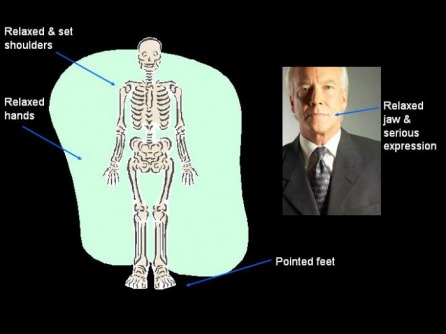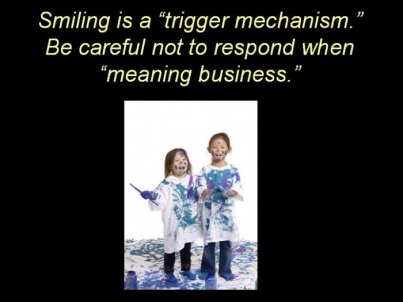Limit Setting

Part of remaining consistent with students is to have limits in place and express them through body language.
Description:
In order to effectively convey meaning with students while remaining calm and consistent, the teacher needs to be aware of their body language. So much of communication is expressed without words, and even the strongest of statements can be undermined through a stance. To convey the idea of “meaning business,” the teacher needs to remain calm and maintain a self-assured stance. This includes a non-smiling, but relaxed face, relaxed but set shoulders, and the entire body (especially feet) pointed toward the individual. If the teacher needs to see a student for misbehavior, this is the stance he or she will assume. If they are working with a student, they will take two relaxing breaths, excuse themselves, and slowly rise. They then begin what is known as the “six second turn.” This involves a full six seconds to turn to face the student. The teacher begins with the head, moving to the shoulders, torso, hips, and feet until they are fully facing the student. They then calmly say the student’s name. Eye contact is important there. The teacher is conveying that they are serious about remaining on task and willing to commit if necessary. There is also no nagging involved, so the students have little opportunity to respond (Jones, 2007).
Significance:
This is significant because it paves the way for future discipline. By conveying seriousness and calmness, the student is made aware that the teacher is not easily moved. There is no “game” involved. This prevents further disruptions because the student is aware of the teacher’s commitment.
Demonstration:
A teacher is helping a student with a problem. From the corner of his eye, he notices student passing notes. He then takes two relaxing breaths, excuses himself from the student he is with, and begins to rise. Taking a full six seconds to turn, he ends up facing the student passing notes with his entire focus directed on him. His face remains calm and body language indicates that he means business. In a non-angry voice, he calls the student’s name.
Integral Components:
Body language reveals much more about one’s true feelings than words do. Students are especially keen on picking up on any sign of weakness or inconsistency. Therefore, conveying business is a matter of stance. After completing the six second turn, the teacher’s face should be relaxed, without clenching the jaw. Students may use “trigger mechanisms,” such as a smile or head tilt to break a teacher’s expression. The smile in particular is one that the teacher must be aware of, as it is natural to smile back. The teacher’s face should remain expressionless, with hands relaxed at their side and feet pointed in the direction of the student. Body posture should be relaxed, but proper, to convey confidence. He or she is also maintaining eye contact throughout (Jones, 2007).
Individualization:
This is a particularly difficult concept because it is so natural to conduct rapid movements, especially in something as automatic as turning. However, the very nature of the unexpected makes this tool even more effective. It will take much practice, but I plan to implement this in my own classroom. Not only will it save energy in the present, but time in the future once students know that I am consistent in “meaning business.”
Spiritual Application:
Proverbs 22:6 states to, “train a child in the way that he should go, and when he is old he will not turn from it” (NIV). Remaining consistent and modeling a calm demeanor is one of the greatest tools in child-training. If that child sees these behaviors, he or she is likely to emulate them, thus the role of the educator has been used to aid in this. We have a great responsibility in being teachers, and displaying a Christ-like character is essential.



